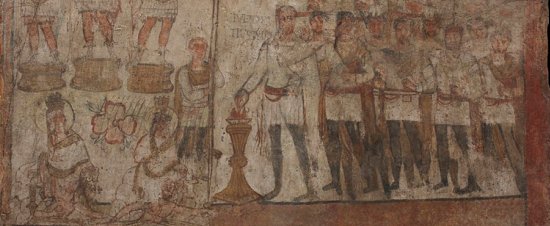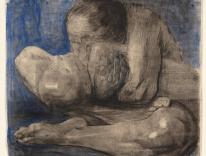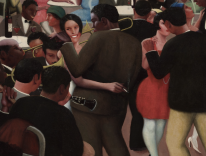
Detail, wall painting from the Temple of the Palmyrene Gods, Dura-Europos, ca. 239 CE, © 2011 Yale University Art Gallery
In 1931, a team of archaeologists discovered the earliest clearly dateable Christian church: a third-century “house church” in Syria. Situated on what was once the eastern frontier of the Roman Empire in the cosmopolitan military town of Dura-Europos, the Christian building was in use for several decades of the third century before being buried by the Romans to build a rampart against the invading Persians.
This house church became widely celebrated soon after its discovery. Some called Dura-Europos the “Pompeii of the desert.” The surviving wall paintings from the church’s baptistery, which are among the earliest Christian art found anywhere, were installed in the Yale University Art Gallery. Fifty years later it was decided that the paintings were materially unfit for further display, and they were removed from the gallery.
From September 23 to January 8, 2012, some of the antiquities from Dura-Europos are on display in an exhibition at New York University’s Institute for the Study of the Ancient World. The exhibition, titled “Edge of Empires: Pagans, Jews, and Christians at Roman Dura-Europos,” is a collaboration between the Yale University Art Gallery and Boston College’s McMullen Museum of Art.
Among the most interesting items on display are the fragments of the baptistery. The rite of Christian initiation at Dura-Europos took place in a room full of wall paintings. Among the surviving paintings are rare pre-Constantinian depictions of Jesus Christ. The New York installation displays two scenes from the upper panel of the northern wall of the building; scholars believe these paintings were part of a series that portrayed the mighty deeds of Christ. The left side depicts the healing of a paralytic, while the one on the right shows Jesus and Peter walking on the Sea of Galilee.
In the Gospels of Mark and John, only Jesus walks on the water, a sign of his unique power over nature: he alone reigns over the chaos of the sea. In Matthew’s version of this episode, Peter leaves the boat to walk toward Jesus. When Peter becomes frightened, he begins to sink and cries out for help. He is the model of a bold yet floundering disciple, and this representation of him sinking into the sea before being saved by Jesus furnished the early church with a powerful image of baptism. Before the Gospel of Matthew was written, the apostle Paul had already described the death and resurrection of baptism as a kind of drowning and rising up from the water. There is a key difference, however, between Paul’s version of this metaphor and Matthew’s: in Paul, the believer descends with Christ into the watery grave; whereas in Matthew’s story, Christ is the one who does not sink, and that is precisely the point.
Most viewers of the wall painting would probably identify the figure on the left as Peter, drowning in his lack of faith and reaching up to Jesus for salvation. As it turns out, the figure on the left is Jesus, and Peter is walking toward him from the boat on the right. So this wall painting does not depict the familiar “sinking Peter” scene found in later Christian art. The figure on the left is painted lower on the picture plane so that he will appear to be in the foreground, not so that he will appear to be sinking. We are looking at the scene before Peter’s moment of panic. Here Peter imitates Christ in his power, not his death.
Below this scene is one picturing a procession of women approaching a large structure. They are veiled, dressed in white, each carrying two items: a torch in the right hand and a vessel in the left. Who are they? Perhaps they are the women going to the empty tomb of Jesus to anoint his corpse. In that case, the torches guide their way in the dark morning hours or inside the tomb, while the vessels carry unguents, with the structure to the left being a sarcophagus. Their prominence in this ritual context would signify the Christian interpretation of immersion baptism as a kind of death and resurrection.
But a few scholars, myself included, now see a different image on the wall. In many early texts about rites of anointing and baptism, especially those of Eastern provenance, metaphors of death and resurrection are either absent or subordinated to other metaphors. Metaphors that related baptism to weddings—with bride, bridegroom, bridal chamber, wedding feast, bridesmaids, and even “best man” all figuring in the comparison—were widespread in early Christianity, and scholars have begun to interpret the baptistery at Dura-Europos applying these metaphors. So, what if we view the women as processing not to a tomb, but to a wedding? In that case, we are being asked to imagine the initiation not as death, but as spiritual marriage to Christ. The painting may even represent Jesus’ famous parable of the ten virgins: five of them persevere until midnight—with torches and containers of oil to keep their torches burning—to meet the long-awaited bridegroom, who was interpreted by early Christians as the Christ of the second coming.
Still, such a painting in such a place might have had more than one meaning or function. Whether the women are on their way to a tomb or to a wedding, they may also have been intended to propel the candidates for baptism forward toward the font, a parallel line to a parallel destination. Though the painting is now displayed as art in a museum, one should try to imagine walking past these processing figures in their original context: a nighttime ritual initiation in the dimly-lit baptistery of an ancient Christian church. The meaning of what appears on walls like those of this baptistery becomes clear only when we remember what happened between them.
This article is adapted from Peppard's essay in Dura-Europos: Crossroads of Antiquity (McMullen Museum of Art, 2011) and from his forthcoming lecture at the Institute for the Study of the Ancient World on November 3.
Please email comments to [email protected] and join the conversation on our Facebook page.
Previous Story
Wasn’t It Bad Enough?
Next Story
Is Cain able? (II)


